Whale barnacle
| Coronulidae | |
|---|---|
 | |
| Cryptolepas rhachianecti on a grey whale | |
| Two Cryptolepas rhachianecti | |
| Scientific classification | |
| Kingdom: | Animalia |
| Phylum: | Arthropoda |
| Subphylum: | Crustacea |
| Class: | Maxillopoda |
| Subclass: | Cirripedia |
| Order: | Sessilia |
| Suborder: | Balanomorpha |
| Superfamily: | Coronuloidea |
| Family: | Coronulidae |
| Genera [2] | |
| |
Whale barnacles are barnacles belonging to the family Coronulidae. Whale barnacles attach themselves to the bodies of baleen whales during the barnacles' free-swimming larval stage. Some sources[3] describe the relationship as an example of obligate commensalism. This means that the whale is neither harmed nor helped by the barnacle, while the barnacle (a filter feeder) benefits from access to food as the whale passes through the water. Others describe the relationship as parasitic. The relationship is parasitic when whales are harmed by the barnacles. Such harm occurs when heavy infestations cause drag and reduce swimming efficiency. In addition, barnacle infestations can aid other parasites especially cyamids.[4] Whale barnacles that, through circumstance, are forcibly detached from their whale have been noted to experience apoptotic necrosis triggering[5] the decline and eventual demise of the individual. A number of taxa formerly treated as subfamilies of Corolunidae are now considered separate families in their own right, including the turtle barnacles in the family Chelonibiidae.[6]
References
- ↑ Benny K. K. Chan (2012). "Coronulidae". World Register of Marine Species. Retrieved June 6, 2012.
- ↑ ITIS
- ↑ "How Do Barnacles Attach to Whales? » Scienceline". Scienceline. 2010-03-22. Retrieved 2018-03-22.
- ↑ Yasuyuki Nogata & Kiyotaka Matsumura (2006). "Larval development and settlement of a whale barnacle". Biology Letters. 2 (1): 92–93. doi:10.1098/rsbl.2005.0409. PMC 1617185. PMID 17148335.
- ↑ Tait, Stephen W. G.; Ichim, Gabriel; Green, Douglas R. (2014-05-15). "Die another way – non-apoptotic mechanisms of cell death". J Cell Sci. 127 (10): 2135–2144. doi:10.1242/jcs.093575. ISSN 0021-9533. PMC 4021468. PMID 24833670.
- ↑ Ryota Hayashi (2012). "Atlas of the barnacles on marine vertebrates in Japanese waters including taxonomic review of superfamily Coronuloidea (Cirripedia: Thoracica)". Journal of the Marine Biological Association of the United Kingdom. 92 (1): 107–127. doi:10.1017/S0025315411000737.
External links
